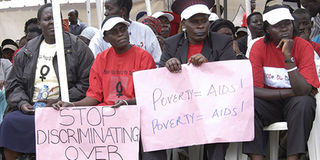1.4m living with HIV but rate of infection down

File | NATION
Activists at the launch of HIV/Aids campaigns at the KICC in Nairobi last year.
What you need to know:
- Experts say reducing the infection rate among risk groups could lower spread of deadly virus
The war on Aids needs a more aggressive approach to reach the high risk groups. This is the message to the government as the country marks World Aids Day on Wednesday.
About 1.45 million people are living with HIV and Aids in Kenya, but experts say reducing the infection rate among risk groups could lower the prevalence rates drastically.
Statistics show heterosexual couples in steady relationships account for 44.1 per cent of new infections compared to 20.2 per cent among people in casual relationships.
Sex workers and their clients report 14.2 per cent of new infections, whereas drug users were responsible for 3.8 per cent. Men who have sex with men were also identified as a risk group at 15.2 per cent.
The National and AIDS/STI Control Programme (Nascop) head, Dr Nicholas Muraguri, says they are working on identifying the risk groups and rolling out prevention programmes.
Kenya reports 91,000 annual deaths from Aids. About 438,000 adults are estimated to be in need of antiretroviral therapy compared with 117,000 children. Dr Muraguri says focus is on reducing mother-to-child transmission.
The 2008 Kenya Demographic and Health Survey indicates that 81,000 mothers are in need of prevention of mother-to-child transmission programmes.
Women have the highest burden of HIV, followed by children. They also have a higher HIV prevalence at eight per cent compared to men’s 4.3 per cent against a national prevalence of 6.3 per cent.
However 70 per cent of the men were found to use condoms compared with 35 per cent women.
Dr Ibrahim Mohammed from Nascop said about 1.5 million people accessed Voluntary and Counselling and Testing (VCT) services in 2009 and 97 per cent of them accepted HIV testing. Of these, 7.4 per cent were positive.
In the absence of intervention there is a 30 per cent to 45 per risk of transmission of HIV from mother to child.
Sixty per cent of infections occur during pregnancy and delivery, and 40 per cent during breastfeeding.
Nascop estimates 1.5 million babies were born in 2009, and that as many as 7.1 per cent of pregnant women in Kenya were living with HIV.
Dr Muraguri says that there were 22,000 child infections, compared to 100,000 adult infections in 2009.
The country’s HIV prevalence stands at 6.3 per cent but, the figure varies with regions.
According to the 2009 Kenya Demographic and Health Survey, Nyanza Province reported the highest prevalence of 13.9 per cent followed by Nairobi with 7.0 per cent and Western 6.6 per cent.
North Eastern Province recorded the lowest prevalence rates with 0.9 per cent and Eastern 3.5 per cent.
Rift Valley and Coast reported 4.7 and 4.2 per cent respectively, while Central had 4.6 per cent.
Kenya hopes to eliminate mother-to-child transmission of HIV by 2015 and to achieve transmission rates of less than 5 per cent.
The challenges the country faces include low male involvement in prevention programmes and low antenatal clinic attendance.




